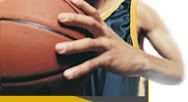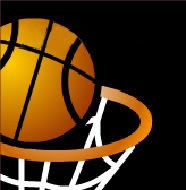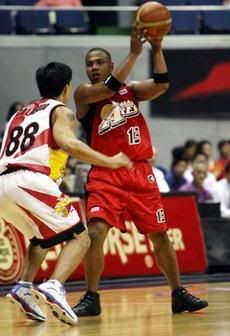Heart & Sole
INSIDE THE LOCAL SNEAKER WARS
By Rick Olivares
Business Mirror
October 6, 2007
If in his early years, Michael Jordan was simply “Air,” in the Philippines, Billy Ray Bates, the former Portland Trailblazers star, was Superman.
His on court feats in the Philippine Basketball Association (PBA) were so prodigious, so superhuman (he led his teams, the Crispa Redmanizers and Ginebra San Miguel to three titles in three of four conferences) that Grosby shoes put out a special edition of Superman shoes with Bates’s autograph on them.
They were bestsellers even if they netted a sum of P75 back then. More importantly, it gave Grosby a presence in the market that was dominated by foreign brands Converse and adidas.
The boys of summer
BARANGAY Olandes in Marikina is a stone’s throw away from the Riverbanks Mall and a three-minute drive away from posh Eastwood and Sta. Lucia East. The blue-collar community is surrounded by the more affluent subdivisions of Monte Vista, Cinco Hermanos and Industrial Valley. But during summer vacation, the Saturday night lights burn the brightest in Olandes’s cement floor covered courts where the annual intersubdivision basketball leagues take place.
But when the barangay’s players take the court, like their counterparts from their richer neighbors who go to schools like Ateneo and La Salle, they are on literal equal footing.
Riverbanks is a hotbed for sneaker knock-offs of every kind imaginable, but for the kids of Olandes, they’re simply, pamporma.
“Pagdating sa laro, kailangan ’yung tunay para sa technology at performance,” says Michael de Venecia, one of the barangay’s playground legends.
“The popularity of the brands cuts across all socioeconomic levels,” confirms adidas Philippines’ managing director Joey Singnian. “Having the real-deal shoes is an aspiration that is easily attainable in spite of the cost. Even if it’s a two or three-year-old model, they’ll buy it. Basta meron. There’s a belief that there’s magic in the shoes that gives you a little extra.”
Rolly Malig, a Filipino businessman based in Las Vegas, Nevada, who runs a DVD-rental business, claims that while Filipino-Americans look for local films to watch, one of the top pasalubongs for the people back home are sneakers. “The Internet has literally made the world a smaller place and fans are always on the lookout for new products and trends. And rubber shoes are one of them. You could say that they’re status symbols.”
For many Filipinos who make only the minimum wage, they may not be able to drive a luxury car or even live in a swanky condo, but a pair of authentic sneakers is the closest and perhaps easily attainable item available to them.
Auty Villarama, former Sports marketing manager for Nike Philippines and now chief executive officer for Puma Brand Stores in Makati and Quezon City, recalls a former janitor of the company back during its Mondragon distribution years. At the end of the work day, the janitor would shower and change into his casual clothing and lace up a pair of Air Jordans. ’Yan, the elderly service man would say, “Hindi nila malalaman na janitor lang ako.”
The art of war
THE sneaker business in the Philippines is a billion-peso industry. Adidas alone posted P1.1 billion in domestic sales for 2006. There are a whole bevy of brands from Nike, adidas, Converse, Reebok, Puma, Mizuno, And 1, KSwiss, Accel, Anta and Pony, among others, for consumers to choose from. Every mall, every department store has several of them. In spite of the oversaturated market, the shoe industry can be distilled into the top two—Nike and adidas, and then everyone else. Industry experts estimate that the average Filipino purchases at least three pairs of rubber shoes in a year spread around Christmas, summer and June which is back-to-school for millions of kids.
Villarama is conscious of his brand’s relative smallness when stacked against the Big Two (Nike and adidas), “We closely monitor market trends and comparative pricing of other brands to be able to compete. We don’t have the big budgets they have for marketing and advertising, so we have to make sure that we’re competitively priced and well stocked.”
Anta Philippines chairman James Tanhuy believes that it’s almost suicide to go up against the traditional powers so he’s positioned Anta toward the B and C markets. “We do not offer shoes amounting to P5,000. We want to project a professional athletic shoe brand that is affordable to the masses.”
Although Anta is a new player in the market, they heavily advertised during last year’s National Basketball Association playoffs with an edgy commercial that made use of that sports anthem “We Are the Champions” by British classic rock band Queen.
But shoe retailers across the country agree that consumer acceptance of the new brands is cautious. Some say that their best bet is to go niche; meaning catering to the lifestyle market, a whole new genre in the sneaker wars. “Modesty aside,” says Singnian. “It’s really hard to compete with the muscle of the multinationals. But nature abhors a vacuum so counterculture sneakers will always have their appeal. The mindset of some consumers is, ‘I want something different.’”
An employee of Toby’s, the sporting goods store giant, who refused to be identified, confides that sales agents of all the brands constantly ask about the sales of others. “But mind you, it’s all friendly competition,” clears up Villarama.
“The battle is waged on all fronts,” agrees Rely San Agustin, marketing manager for Basketball TV. “Time was we just had tri-media, in-store promos, events and endorsers. And that’s saying a lot. Today, the battle extends as early as the high-school kids. But if you ask me, I wouldn’t be surprised if it expands to even elementary kids. It’s not an ‘if’ but a matter of ‘when.’”
The call to arms began almost 11 years ago from today in the Beaverton, Oregon, office of Nike. After losing Kobe Bryant to adidas, Nike CEO Phil Knight during an October 19, 1996 meeting with his top brass, walked into his company’s elegant conference room and in a few words called for an escalation to emblazon the world with the Swoosh: “We never want another kid to go pro out of high school again without Nike being involved.”
And with that, the battle which was previously limited to the collegiate and professional level entered a whole new phase. And the Philippines was about to be embroiled in the global conflagration.







No comments:
Post a Comment